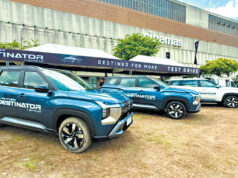Text and photos by Aries B. Espinosa
THEY aren’t just paint jobs, modifications, or overhauls. They’re complete re-imaginings of a Filipino transport icon.
Over the course of less than two months, Isuzu Philippines Corp. (IPC) turned over 30 of its “modernized jeepneys” — built in partnership with local LCV body builder Almazora Motors — to two transport groups in Pasay and Iloilo cities.
The first turnover ceremony took place on June 18 in front of the Senate of the Philippines. The second one, held on July 31, was at a shopping mall in Iloilo City. On both occasions, IPC handed over the keys to 15 modernized public utility vehicles to the two transport groups —the Senate Employees Transport Service Cooperative (SETSCO) and the Metro Express Connect Inc.
The first turnover represented the formal beginning of the implementation of the government’s Public Utility Vehicle Modernization Program (PUVMP), with SETSCO as the pilot operator. On the other hand, the July 31 affair marked the start of the same program in Western Visayas.
IPC’s modernized PUVs, looking more like mini-buses, bear no likeness to traditional jeepneys. They have been assembled using the Isuzu QKR77 platform and the rear body was designed and is manufactured by Almazora Motors Corp. These are air-conditioned Class 2 vehicles with side-facing seats. The Isuzu QKR platform is assembled in the Philippines and is equipped with a Euro4-compliant 4JH1-TC diesel engine that delivers better fuel economy and cleaner emissions than jeepneys.
The new PUV body is compliant with Philippine National Standards (PNS 2126:2017). The passenger cabin floor-to-ceiling height and gangway width are 1,780 millimeters and 830 millimeters, respectively, providing more space for passengers to move easily inside. The passenger door is safely situated on the right-hand side, facing the sidewalk. Other design features of the body include panoramic windows and windshields, full-body insulation with GeneQ shield, automatic door closer, and provisions for persons with disabilities.
Completing the modernized look and features of the new PUVs are the LED TV monitors for real-time information, including station details, route, date, time, weather, news and advertisements. Other items count in LED electronic signage for vehicle route information, fire extinguishers, a CCTV system, dash cam and back-up cameras, and the automatic fare collection device. All are geared for passengers’ safety, entertainment and added convenience in fare collection.
The new PUVs’ warranty coverage for cab and chassis is three years, or 150,000 kilometers, whichever comes first, and has a separate warranty for the body, air-conditioner and accessories — options not available in old jeepneys.
IPC president Hajime Koso, who graced both events, said; “These are truly landmark events for the PUVMP of the Philippine government and IPC’s active participation in this timely project. The fruitful collaboration between IPC and the wholly Filipino-owned Almazora Motors Corp. ensures that our commuters ride only in world-class public utility vehicles that also take into careful consideration passenger safety, comfort, and the particular locality’s needs.”
The PUVMP is envisioned to replace some 250,000 jeepneys nationwide with new, safe and environment-friendly, secure, convenient and comfortable PUVs. The 30 modernized PUVs may seem like a drop in the bucket, but it gives the popular Japanese LCV and truck maker a distinct headstart in this largely untapped market.



